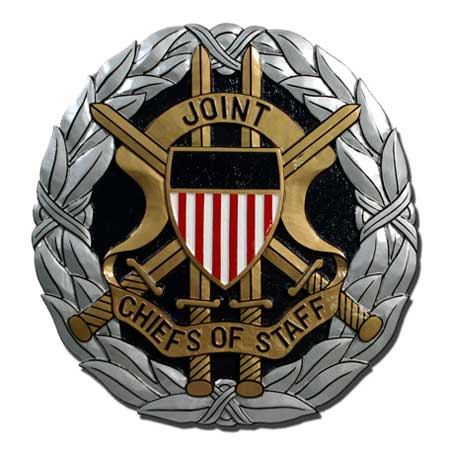There will be those that remember this event like it happened yesterday, those that vaguely remember hearing something about it, and those that have no idea that this was even an issue. Nevertheless, on November 10th, 2011, all of the members of the Joint Chiefs of Staff were brought before the Armed Services Committee (first time that ALL of them were brought in the room at the same time in recent history), and asked a simple question: “How to do you feel about making the Chief of the National Guard Bureau a statutory member of the Joint Chiefs of Staff?”
Here is what they had to say…
[KGVID poster=”https://langea.org/wp/wp-content/uploads/2013/11/JCS-Testimony-Video_thumb2569.jpg” width=”720″ height=”480″ downloadlink=”true”]https://langea.org/wp/wp-content/uploads/2013/11/JCS Testimony Video.mp4[/KGVID]
Mm-kay. Each of them told the American public that if we want the opinion of the National Guard on things like equipment, mission sets, or benefits, we’ll ask for it. Until then, we don’t need your involvement, only your stuff. Doubt that statement? Do you really think that Active Duty is adequately looking out for the National Guard? Ask yourself why the National Guard has to wait until age 60 to get their pro-rated pension check? Or about Active Air Force insisting that the Guard can absorb dramatic cuts to their end-strength, while they poached National Guard missions to justify keeping post 9/11 increased Active Duty end strength on the books. In this time of tight budgets, here is pretty much all you need to know: The National Guard and Reserves Components cost less than 1/3 of Active Duty. Some highlights of the Reserve Forces Policy Board study published early in 2013:
- The cost of an RC service member, when not activated, is less than one third that of their AC counterpart. According to RFPB analysis of the Fiscal Year 2013 budget request, the RC per capita cost ranges from 22% to 32% of their AC counterparts’ per capita costs, depending on which cost elements are included.
- While Reserve Component forces account for 39% of military end strength, they consume only about 16% of the Defense budget.
- Reserve component members receive a smaller retirement than their active component counterparts. The RC accounts for approximately 17% of DoD retiree payout. The FY 2013 average Retired Pay Accrual is $12,834 per AC service member, but only $3,419 per RC service member.
- Reserve component members incur lower health care costs. For FY 2013, DoD requested $32.5 billion for the Defense Health Program (plus nearly $8 billion in military medical personnel funds and nearly $7 billion in Medicare-eligible Retiree Health Care accrual funds) to serve more than 9.5 million beneficiaries. Only about 21% of those beneficiaries are from the Reserve Components, and as a whole, the RC member uses the system less than AC members.
- RC members serve in their home town and rarely incur military moving costs for “Permanent Change of Station”, for which DoD requested $3,260 per AC service member in FY’13.
- With few exceptions, Reserve families do not send dependent children to DoD schools, and only reservists serving on active duty are counted for Impact Aid calculations. For FY 2013, the DoD Education Activity requested $2.7 billion and the Department of Education’s “Impact Aid” program requested $505 million. The project team estimates that reservists account for approximately 1% of the DoD’s and approximately 2% of the Department of Education’s funds to educate military dependents.
- Generally, reservists are ineligible to use the military family housing system, which required $1.3 billion to build and operate in FY’13. Only reservists on active duty orders qualify for on-base housing, and few use it.
- Reservists do not drive the need for military commissaries, which in FY 2013 cost $1.37 billion over and above revenue income in order to operate. Only 3% of commissary users are from the Reserve Component.
So, if you were paying attention to the Joint Chief’s testimony a couple of years ago, you know what happened next….
[KGVID poster=”https://langea.org/wp/wp-content/uploads/2013/11/Graham-Support-of-NG_thumb146.jpg” width=”720″ height=”480″ downloadlink=”true”]https://langea.org/wp/wp-content/uploads/2013/11/Graham-Support-of-NG.mp4[/KGVID]
Now, you may not agree with everything that Senator Graham does in D.C., but you have to admit that bigger fans of the National Guard are hard to find. And, only a couple of months later, the National Defense Authorization Act was signed by the President, and the Guard is now sitting at the table. But in reality, all that means is that the fight is just getting started. The National Guard 4-Star General, General Frank Grass (and General Craig McKinley before him), were in a room full of people that just said that the National Guard should not be there. By the way, click on the link for General McKinley and take a look at how happy the JCS were that the Guard was in the room. They were so happy, that not a single quote from anyone other than General McKinley was mentioned in the press release from the Joint Chiefs of Staff on their own website! Perfect.
Riddle me this Batman.
- USMC troop end-strength = 197,300. Number of 4-Star Generals…..? It was SIX not that long ago. Now down to FOUR, I think.
- Army and Air Guard Troop strength = 463,900. Number of 4-Star Generals……? One, and we had to get Congress involved to get that.


